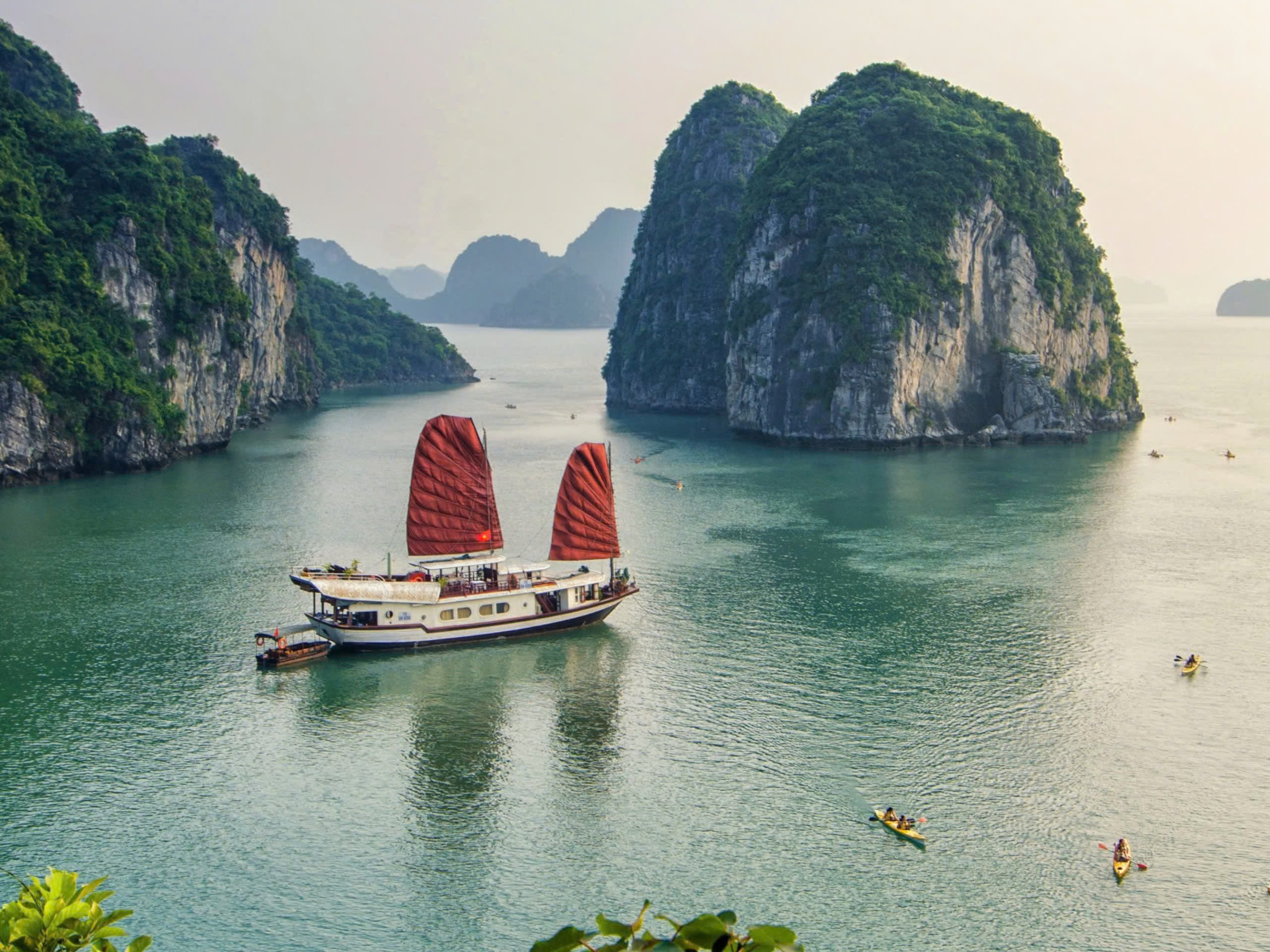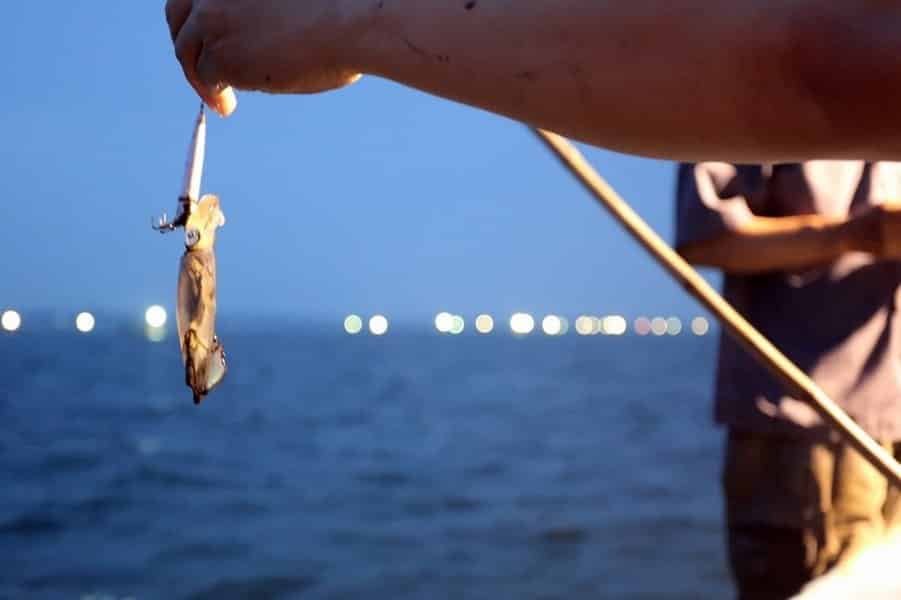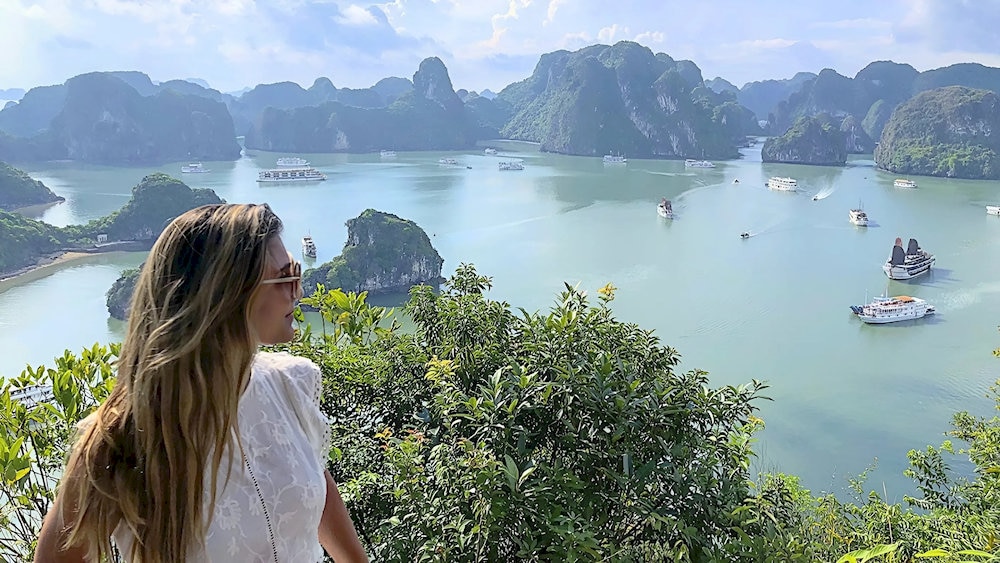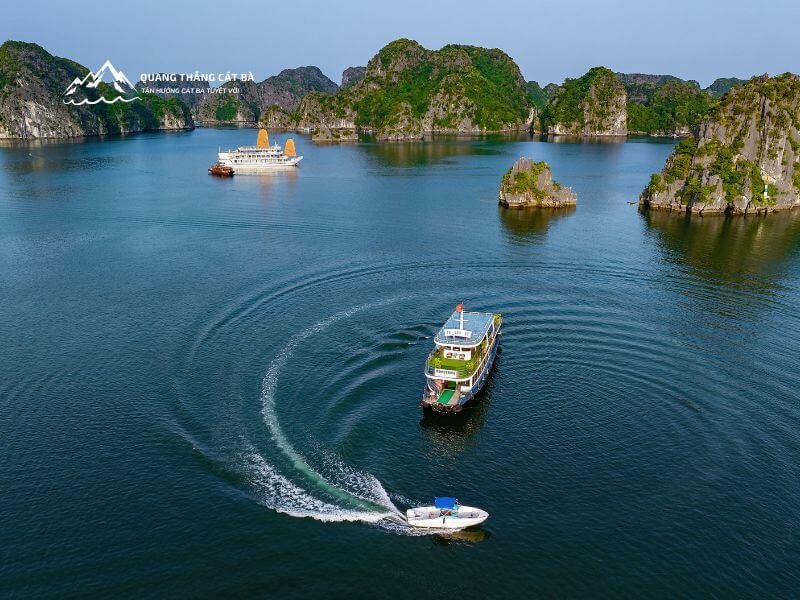Jagged limestone karsts rise dramatically from emerald waters, forming a seascape so surreal it feels almost mythical. Ha Long Bay stands as one of Southeast Asia’s most breathtaking natural wonders, offering more than just a pretty view—it invites you into an ancient realm shaped by wind, waves, and legend. With floating fishing villages, secluded grottoes, and peaceful overnight cruises, this UNESCO World Heritage Site reveals Vietnam’s coastal soul in the most unforgettable way. Ideal for adventurers, photographers, and serenity seekers alike, this guide uncovers how to experience Ha Long Bay beyond the surface—through hidden gems, local insights, and must-know travel tips.
Choose a 2–3 night cruise beyond Ha Long Bay

Shorter day cruises barely skim the surface of Vietnam’s karst seascapes. With a 2–3 night cruise, the experience shifts from snapshot tourism to meaningful immersion. Guests gain time to enjoy more than just iconic Ha Long Bay—sailing further into lesser-touched waters, soaking in dawns and sunsets without rushing. Multi-day itineraries also allow time to unwind between activities like kayaking, cave explorations, beach stops, and cultural onboard classes. Many routes offer second-day detours to remote corners of Bai Tu Long or Lan Ha Bay, where limestone towers rise undisturbed. Nights at sea—anchored under starlit skies—offer a peace that’s impossible to replicate during shorter sails. Floating in a sea of stone giants while the boat drifts through mirror-still waters at golden hour is something a day trip simply can’t deliver. Multi-day journeys also mean upgraded cabins, better cuisine, and deeper service, elevating comfort without sacrificing authenticity. Whether watching squid boats light up the distance at midnight or joining dawn Tai Chi on the top deck, extended cruises reward travelers with layered, lasting memories. For those seeking slow, scenic travel with cultural richness and marine adventure, a 2–3 night voyage provides the space and pace that this surreal landscape deserves.
Opt for Bai Tu Long or Lan Ha Bay to escape crowds

Mainstream Ha Long Bay itineraries tend to cluster around similar routes, especially near Sung Sot Cave and Titop Island. Travelers looking for serenity should consider Bai Tu Long or Lan Ha Bay—two neighboring stretches that mirror Ha Long’s beauty but with a fraction of the foot traffic. Bai Tu Long lies northeast and remains the least commercialized, offering tranquil waters, forest-cloaked islets, and interactions with authentic fishing communities. Lan Ha Bay, southwest near Cat Ba Island, impresses with its vibrant marine life, more accessible kayaking zones, and often clearer water. Both alternatives still boast the towering limestone formations and hidden lagoons that define the Gulf of Tonkin, yet they remain less frequented by large tour operators. Cruises through these routes often operate on smaller vessels with more personalized service and allow for peaceful anchoring in quiet coves. Exploring these quieter bays also aligns with sustainable travel principles, dispersing tourism more evenly and preserving Ha Long Bay’s core. While iconic spots have their charm, the immersive silence and pristine beauty of these lesser-known waters elevate the journey. For travelers seeking unique, crowd-free experiences that feel intimate and untouched, Bai Tu Long and Lan Ha Bay are compelling alternatives worth prioritizing.
Board a traditional wooden junk for authentic vibes

Sailing through Vietnam’s limestone seascapes aboard a handcrafted wooden junk delivers more than transport—it’s a cultural experience in itself. These traditional vessels, modeled after historical Chinese and Vietnamese designs, are typically made from teak or ironwood and feature distinctive curved sails, polished decks, and rustic charm that modern ships simply can’t replicate. Onboard, you’ll find warm interiors, carved wood detailing, and often a local crew offering rich insights into regional customs. Some junks have been upgraded with luxury amenities while preserving their old-world character, creating a fusion of comfort and authenticity. Guests often report a deeper sense of place when cruising on a wooden junk compared to newer steel boats, especially when sailing past fog-draped cliffs or anchored in still bays under starlight. The experience feels timeless—especially during quiet moments with just the creaking of wood and soft lapping of emerald waves. Choosing a traditional junk also supports local craftsmanship and heritage preservation, as many of these vessels are still built in northern Vietnam using time-honored techniques. For travelers chasing an atmosphere that mirrors the mystique of the bay, a wooden junk cruise offers not only scenic beauty but cultural texture that lingers long after disembarkation.
Start pre-dawn for golden hour on calm emerald waters

Early risers aboard overnight cruises are rewarded with an ethereal transformation as Ha Long Bay stirs from slumber. Before sunrise, the water lies glassy and undisturbed, mirroring the silhouettes of towering limestone karsts under a gradient sky. Mist often clings to the cliffs, and the only sounds are the rhythmic strokes of a passing fishing boat or the call of seabirds. This golden hour—best viewed from the upper deck—casts a warm hue over the bay, illuminating the emerald tones in the water and revealing a depth of color often missed during daytime glare. Photographers and nature lovers find these early hours ideal for capturing the bay’s raw beauty without interruption. Most overnight cruises schedule Tai Chi sessions around this time, but even standing silently with a warm drink in hand is enough to feel connected to the setting. The pre-dawn hours also offer the clearest views, as both haze and crowds are absent. Whether used for quiet reflection, sunrise yoga, or a simple morning gaze, this peaceful window sets the tone for a slower, more intentional day on the water. For an unforgettable start, nothing compares to golden hour in the Gulf of Tonkin’s still embrace.
Kayak through hidden lagoons and cave entrances

Adventurous travelers often cite kayaking as the most rewarding way to experience Ha Long Bay and its sister regions. Paddling offers access to places larger boats simply can’t reach—narrow cave tunnels, tucked-away lagoons, and overhangs shaded by ancient rock. Guided kayaking excursions are typically included in 2–3 night cruises and lead visitors through serene areas like Luon Cave or Dark and Bright Cave in Lan Ha Bay. Inside these pockets of tranquility, the water shifts to sapphire hues, and limestone cliffs rise dramatically overhead, often covered in orchids and nesting seabirds. Silence reigns, broken only by the drip of water from stalactites or the splash of a paddle. Kayaking also allows for a slow pace, ideal for spotting wildlife like monkeys or kingfishers along the cliffs. Some routes take paddlers into circular lagoons surrounded by vertical walls—natural amphitheaters hidden from open sea. Safety is prioritized, with calm waters and life vests standard. First-time kayakers find the activity beginner-friendly and deeply rewarding. Beyond physical exercise, kayaking delivers a personal encounter with Vietnam’s karst geography—far more tactile and intimate than observing from a deck. For those craving immersive exploration, this quiet adventure weaves memory with motion in unforgettable ways.
Paddle bamboo boats in secluded fishing villages

Gliding through calm waters in a hand-rowed bamboo boat provides a slower, deeply local glimpse into life along the bay. These boats, steered by skilled villagers—often elderly women in conical hats—navigate narrow canals and floating communities with grace. Villages like Vung Vieng in Bai Tu Long or Cua Van in Ha Long Bay offer these traditional boat rides as a way to support local incomes while sharing their culture firsthand. As you drift past floating homes, anchored fish cages, and colorful boats, the daily rhythms of bay life unfold—children heading to floating schools, nets being repaired, or crabs being sorted for market. These villages, built entirely on water, offer a rare look into a way of life that predates tourism. Bamboo boats can access areas even kayaks can’t enter, especially in tide-sensitive channels. With no engines, the journey is peaceful and environmentally low-impact. Most tours are included in multi-night cruises and last 30 to 60 minutes, allowing enough time to appreciate the slower tempo and unfiltered charm. For travelers seeking genuine connection over scenic snapshots, bamboo boat rides offer a meaningful pause—a chance to witness resilience, community, and tradition gently floating amid the limestone giants.
Explore Sung Sot & Thien Canh Son caves

Among Ha Long Bay’s many natural wonders, few sites captivate like its majestic caves. Sung Sot Cave—meaning “Surprise Cave”—sits on Bo Hon Island and is the largest in the bay. Visitors climb a stone path to enter a vast chamber where colored lights reveal towering stalactites, stalagmites, and vaulted ceilings sculpted over millennia. The second chamber opens into an even grander space, often drawing gasps from first-time guests. Thien Canh Son, located in Bai Tu Long Bay, requires a gentler climb and leads to a smaller, less-trafficked grotto filled with intricate formations shaped like lotus flowers and guardian lions. It’s ideal for travelers seeking serenity and fewer crowds. Both caves are typically included in longer cruise itineraries and guided by local experts who explain legends, geological history, and cave preservation efforts. The interior temperature stays cool, offering a welcome break from the tropical heat. Exploring these natural caverns not only adds variety to the maritime scenery but also deepens appreciation for the bay’s ancient terrain. Whether drawn to the awe-inspiring size of Sung Sot or the quieter elegance of Thien Canh Son, visiting these caves offers a grounding, unforgettable step inside Vietnam’s mysterious stone world.
Join a sunrise Tai Chi session on deck

As light creeps over the horizon, a quiet ritual begins atop many cruise decks—Tai Chi at sunrise. This meditative martial art, practiced slowly and fluidly, provides a gentle way to stretch and awaken while surrounded by the calming energy of limestone islets and open water. Most overnight cruises invite guests to join complimentary sessions led by trained instructors, requiring no experience and welcoming all ages. Participants move in unison, following graceful postures that mimic natural elements like water and wind. The setting amplifies the serenity: cool morning air, soft bird calls, and the rhythmic motion of the sea create an ideal atmosphere for stillness. Tai Chi improves circulation, reduces stress, and sharpens focus—offering benefits that last well beyond the cruise itself. Practicing on deck as the bay glows gold fosters a unique connection to the landscape, blending cultural immersion with physical wellness. For many, it becomes a highlight—not just as an activity, but as a memorable state of presence amid nature’s grandeur. Whether done for mindfulness or simple curiosity, sunrise Tai Chi offers a meaningful way to begin the day gently aligned with both breath and scenery.
Learn to make Vietnamese spring rolls on board
.jpg)
Hands-on cultural experiences elevate any journey, and learning to make Vietnamese spring rolls adds flavor—literally and figuratively—to time on the bay. Most cruise itineraries include an interactive cooking demo where passengers gather on deck or in the dining area to try their hand at crafting gỏi cuốn (fresh rolls) or chả giò (fried rolls). Led by the onboard chef or a local guide, guests are introduced to essential ingredients like rice paper, vermicelli noodles, fragrant herbs, and regional sauces. The demonstration highlights techniques such as soaking the wrappers, rolling tightly without tearing, and balancing fillings for texture and taste. These sessions are brief but engaging, making them ideal for travelers of all ages and culinary skill levels. Beyond enjoyment, they offer a deeper look at Vietnam’s food culture—light, fresh, and rooted in balance. Some cruises expand the lesson with stories about traditional ingredients, regional variations, and home-cooking customs passed through generations. Tasting your creation against a backdrop of karst cliffs makes the moment even more memorable. As a bonus, recipes are often shared to take home, allowing travelers to recreate a piece of the journey in their own kitchen.
Try night squid fishing under lantern glow

Evenings aboard a Ha Long Bay cruise don’t end with dinner. Once anchored, many boats invite guests to participate in traditional squid fishing—a night pastime enjoyed by local fishermen for generations. The boat crew sets up spotlights along the side deck, drawing squid toward the light, which mimics moonlit water. Using simple hand reels with dangling hooks, guests lower their lines into the calm black sea. The experience is quiet, patient, and punctuated by the thrill of spotting tentacled shadows near the surface. While squid catches aren’t guaranteed, the excitement comes from the ambiance: glowing lanterns, gentle waves, and distant silhouettes of other boats flickering in the dark. For those lucky enough to reel one in, the catch is often cooked fresh on board—grilled or sautéed as a late-night treat. Even without a successful catch, the activity offers insight into coastal traditions and an intimate window into nighttime bay life. The crew typically offers tips and anecdotes, turning the lesson into an entertaining cultural exchange. For travelers seeking to engage beyond sightseeing, night squid fishing offers a tactile, authentic connection with Vietnam’s maritime heritage under a starry sky.
Swim off deserted beaches tucked between karsts

Hidden coves and sandy alcoves pepper the limestone labyrinth of Ha Long, Lan Ha, and Bai Tu Long bays. When conditions permit, cruise boats anchor near these secluded beaches, allowing guests to dive into turquoise waters and wade ashore for a refreshing escape. These beach stops are often untouched—no vendors, no crowds—just powdery sand framed by towering cliffs and jungle brush. The contrast between cool, jade-toned water and warm sunlit rock creates a sensory paradise. Many itineraries schedule time for swimming or snorkeling during midday or late afternoon when the light paints the cliffs in golden tones. Life jackets are provided, and crew members supervise, ensuring safety for all. Some beaches are accessible only by kayak or tender boat, enhancing the sense of discovery. Depending on the location, shells, coral fragments, and hermit crabs can be found scattered along the shore. For families, couples, or solo travelers, these swim stops offer unstructured joy—time to float, splash, or simply sit with feet in the surf. It’s a chance to experience the bay’s raw beauty not just from a distance, but fully immersed. Few activities rival the simple pleasure of swimming between ancient limestone giants in silence and solitude.
Stargaze from deck lounge when anchored offshore
.jpg)
When the anchor drops and the engines hush, nightfall brings a different kind of spectacle to Ha Long Bay. Away from the glow of cities, the sky opens wide, revealing a blanket of stars that mirror the dark silhouettes of the karsts below. The stillness at sea heightens every sensation—the sound of water lapping gently against the hull, the occasional distant call of a seabird, and the cooling breeze brushing across the deck. Guests are encouraged to bring a blanket or lie back on cushioned loungers to simply gaze upward. With minimal light pollution, constellations become vivid, and even shooting stars sometimes streak overhead. Some small-group cruises offer guided stargazing sessions or provide star maps for those curious to identify Orion’s Belt or the Milky Way. Whether enjoyed in conversation or solitude, this quiet experience offers a humbling reminder of the vastness above and the ancient stillness below. After a day of kayaking and exploring caves, stargazing adds a meditative close—replacing stimulation with awe. For romantics, thinkers, and night owls alike, this moment of cosmic reflection beneath the celestial canopy becomes one of the most unexpectedly moving highlights of the entire journey.
Hike up Titop or viewpoint islets for panoramic views

Few perspectives match the sweeping vistas from atop Titop Island or other lookout islets scattered throughout the bay. After a short transfer by tender boat, visitors can embark on a moderately steep hike—about 400 steps—to reach the summit of Titop. The reward is breathtaking: a full panoramic view of limestone pillars stretching endlessly into the horizon, interrupted only by drifting junks and floating villages. Early morning or late afternoon climbs are best to avoid crowds and heat, while also catching golden light that paints the water in rich emerald and sapphire hues. For those cruising through Lan Ha Bay or Bai Tu Long Bay, smaller, less-visited islets also offer scenic viewpoints without the foot traffic of Titop. Most cruise itineraries include these hikes, and proper footwear is advised due to uneven terrain. Benches and shade structures near the top allow time to pause and soak in the landscape. It’s not just the view that lingers—but the physical sense of having climbed above it all. Whether you’re capturing photos or simply savoring the stillness, reaching a high vantage point provides a new lens on the limestone giants, connecting movement, effort, and awe into a single unforgettable moment.
Choose small-group vessels (≤ 16 pax) to reduce impact

Sustainability and intimacy go hand in hand aboard small-group cruises through Vietnam’s karst-studded bays. Vessels limited to 16 passengers or fewer offer not only a quieter, more personalized journey, but also a lower ecological footprint. Smaller boats can navigate into shallower waters, access hidden coves, and dock near floating villages with minimal disruption. They often employ local staff, source ingredients regionally, and follow responsible tourism guidelines designed to preserve the fragile marine ecosystem. From reduced fuel use to less waste output, these operations actively minimize their impact on the bay’s biodiversity. Guests, in turn, enjoy more meaningful engagement—fewer crowds during activities, direct interaction with guides, and flexibility in itineraries. Shared meals feel more communal, and solo travelers often find conversation easier in cozier settings. Many boutique operators focus on education as well, offering briefings on conservation efforts, karst formation geology, and the cultural heritage of the fishing communities. For those who value authenticity over spectacle, a small-group cruise creates space for reflection, genuine connection, and responsible exploration. Choosing this format isn’t just a travel preference—it’s a quiet vote for the long-term protection of one of Southeast Asia’s most iconic landscapes.
Combine the cruise with a Cat Ba Island land excursion

Pairing a bay cruise with a land-based visit to Cat Ba Island delivers the best of both worlds—maritime magic and jungle-clad adventure. Located near the southern edge of Ha Long Bay, Cat Ba is the largest island in the region and serves as a gateway to Cat Ba National Park. Most 2–3 night itineraries offer optional excursions that include short hikes, cycling routes, or even overnight stays on the island. A trek through the park reveals limestone mountains draped in tropical foliage, along with rare wildlife like langurs and civets. Some tours include a visit to the Hospital Cave, a hidden wartime facility carved into rock. Others bring travelers to Viet Hai village, accessible only by boat or forest path, where traditional stilt houses dot the landscape. For beach lovers, Cat Co beaches offer gentle surf and clean sands ideal for an afternoon dip. This added land experience introduces a different facet of northern Vietnam—one rich in biodiversity, history, and local life. By combining cruising with on-island exploration, travelers deepen their connection to the region and diversify their adventure. It’s a seamless, rewarding way to extend a bay journey beyond the water without compromising on wonder or authenticity.
